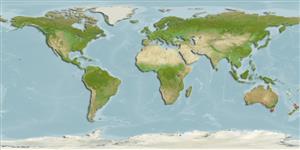>
Gobiiformes (Gobies) >
Gobiidae (Gobies) > Gobiinae
Etymology: Arenigobius: Latin, arena, harena, -ae = sand + Greek, kobios or Latin gobius = gudgeon (Ref. 45335).
More on author: Kner.
Environment: milieu / climate zone / depth range / distribution range
Ecologia
marinhas; estuarina demersal; intervalo de profundidade 0 - 1 m (Ref. 45534). Subtropical
Indo-West Pacific: endemic to southern Australia.
Tamanho / Peso / Idade
Maturity: Lm ? range ? - ? cm
Max length : 7.6 cm SL macho/indeterminado; (Ref. 45534); 9.1 cm SL (female)
Descrição breve
Chaves de identificação | Morfologia | Morfometria
Espinhos dorsais (total) : 7; Raios dorsais moles (total) : 10 - 11; Espinhos anais: 1; Raios anais moles: 10. Distinguished by the following characters: body colour light brown; two oblique dark bands originating on head below eye, the upper degenerating into diffuse purplish brown blotches from the pectoral to caudal peduncle; black stripe arising at the pectoral insertion and running along lower body before breaking into small black spots above anal fin; dorsal fins with a horizontal dark band near the base; dark blue mark on membrane distally between first and second rays of D2; iridescent irregular blue blotches along flanks; three or more approximately vertical bands on upper caudal; vertebrae 10+15 (vertebral counts taken from radiograph); body cylindrical; snout blunt; eyes large, and close together dorsally; origin of pectorals under posterior margin of operculum; caudal oval and elongate; 7th pectoral ray extended into a filament; pelvics united into cup-shaped disc with branched rays; origin of pelvics covered by a loose sheath of skin; scales cycloid on belly and dorsally to second dorsal origin; posterior lateral scales peripheral ctenoid; head and predorsal region naked (Ref. 45534).
Facultative air-breathing (Ref. 126274); Found in muddy coastal areas to upper estuaries, rocky reefs, in sea grass beds and mangroves (Ref. 9002).
Life cycle and mating behavior
Maturidade | Reprodução | Desova | Ovos | Fecundidade | Larvas
Gomon, M.F., C.J.M. Glover and R.H. Kuiter (eds.), 1994. The fishes of Australia's south coast. State Print, Adelaide. 992 p. (Ref. 33839)
Categoria na Lista Vermelha da IUCN (Ref. 130435: Version 2024-2)
Ameaça para o homem
Harmless
Utilização humana
Ferramentas
Relatórios especiais
Descarregue XML
Fontes da internet
Estimates based on models
Preferred temperature (Ref.
123201): 14.6 - 24.9, mean 17.9 °C (based on 272 cells).
Phylogenetic diversity index (Ref.
82804): PD
50 = 0.6250 [Uniqueness, from 0.5 = low to 2.0 = high].
Bayesian length-weight: a=0.00724 (0.00339 - 0.01546), b=3.10 (2.92 - 3.28), in cm total length, based on LWR estimates for this (Sub)family-body shape (Ref.
93245).
Nível Trófico (Ref.
69278): 3.3 ±0.4 se; based on size and trophs of closest relatives
Resiliência (Ref.
120179): Elevada, tempo mínimo de duplicação da população menor que 15 meses (Preliminary K or Fecundity.).
Fishing Vulnerability (Ref.
59153): Low vulnerability (10 of 100).
